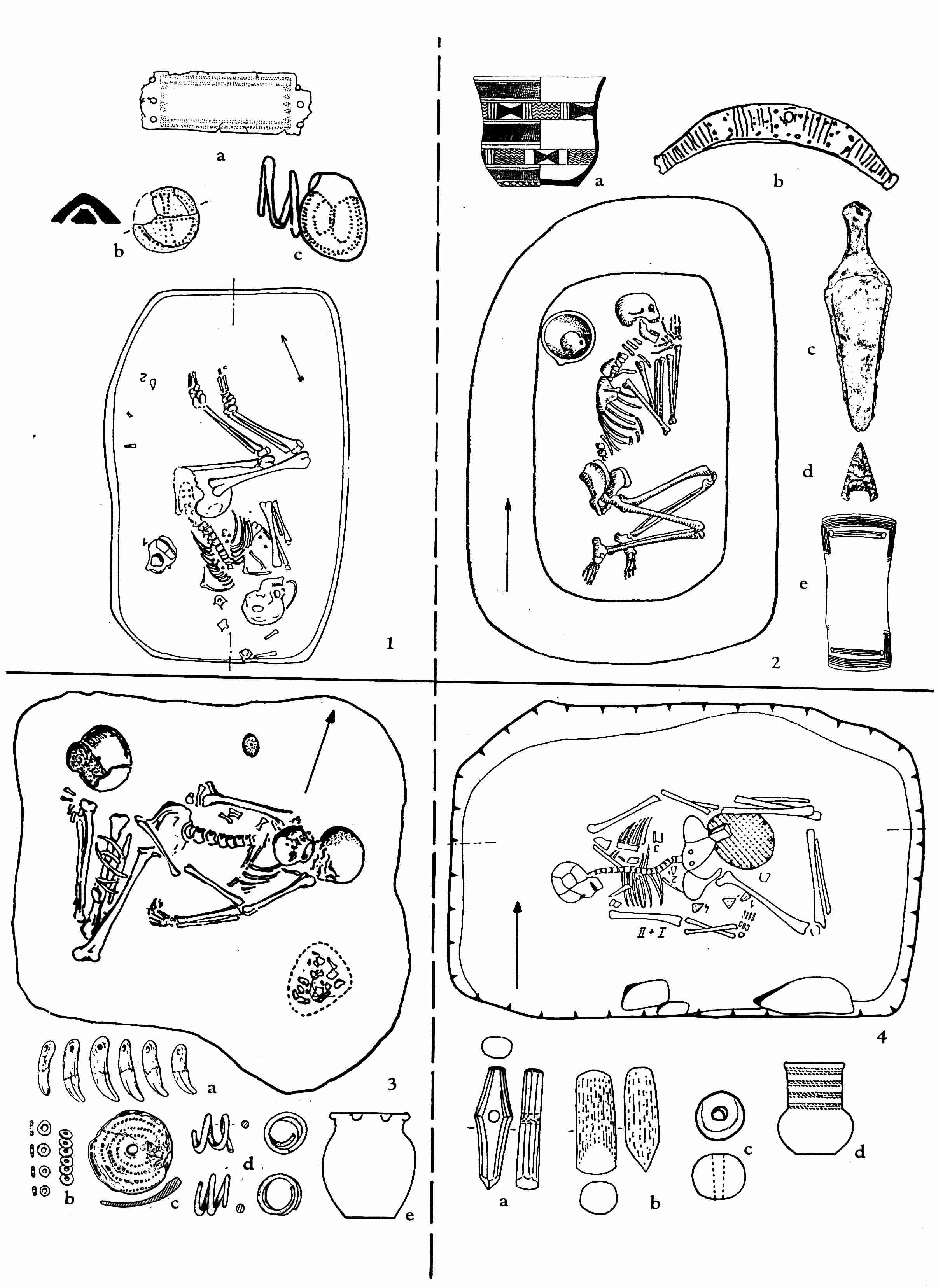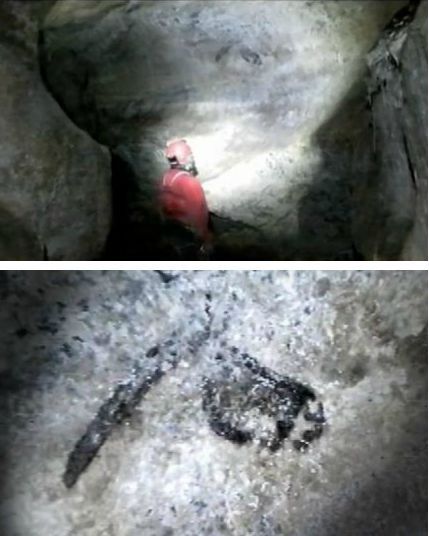Note: partly edited hours after first publication - reason: see comments.
New archaeogenetic research for our delight or confusion, we'll see:
This new study (which I could read in full already) has analyzed the DNA of several individuals buried in Kromsdorf (near Weimar,
Thuringia, Germany) c. 2600 BCE. The burials are said to belong to the Bell Beaker "culture" (better described as
phenomenon in fact) and the results are as follow:
- Grave 1 - 18-21 y.o. man - no DNA reported - laying on his left side, w/ cup
- Grave 2 - 17-20 y.o. woman - no DNA reported - laying on her left side, w/ bowl and bone needle
- Grave 3 - c. 35 y.o. man - mtDNA reported as U2e - laying on his right side, no grave goods
- Grave 4 - a couple:
- 4a - 21-25 y.o. woman - mtDNA reported as W5a - w/ chert flake.
- 4b - a man - no DNA reported - no grave goods
- Grave 5 - 35-50 y.o. man - mtDNA reported as I1, Y-DNA reported as R1b1b2 - no grave goods
- Grave 6 - 6-12 y.o. child (gender unknown) - no DNA reported - no grave goods
- Grave 8 - 21-26 y.o. man - mtDNA reported as K1, Y-DNA reported as R1b - w/ cup and flake
- Grave 9 - a couple:
- 9a - 25-45 y.o. woman - mtDNA reported as U5a1 - w/ loom weights
- 9b - 45-55 y.o. man - mtDNA reported as T1a - no grave goods reported
Edit: I came to accept the reported mtDNA haplogroups as surely correct
As G. Horvat noticed (see comments) the four dubious haplotypes have the 12705C marker, which indicates that they belong to R.
Actually it looks like someone made an error in the tabulation of the results in fig. S7 and both columns 12705 (defining R) and 10873 (defining N) are identical. Considering the reported results and that it seems that the HVS sequences are common today, the 10873 column seems to be in tabulation error, leading to my mistaken previous critical read.
But... coding region markers say it's not even N!
Hat tip to Gail for the heads up here.
In the supplemental material, table S7, the sequence of several coding region markers is reported for the above individuals who yielded mtDNA. The problem is that all sublineages of macro-haplogroup N (and all lineages reported above are that) carry the 10873 site as T. However the burials number 3, 8, 9a and 9b have it as C instead.
This implies that they are L(xN), whatever it is. Sadly the typing of the M-defining site 10400 failed for all samples, so we are a bit amiss. Another anomalous site is 12372: while analysis for this locus failed in the case of nos. 3, 9a and 9b, it was typed as A for the resident of grave 8. I could only find this transition among modern samples (out of N) in M12 and M7c1d. However I tried to track the haplogroup using the HVS markers and I failed miserably (it seems not to be L0 however what is not much help).
So the case for the correct adscription of the mtDNA haplotypes, at least in the four aforementioned cases, is extremely confusing and may well be totally wrong. All I can say is that I doubt that they are U2e, K1, U5a1 or T1a as reported because all these are N subclades and the data says L(xN) quite clearly.
Bell Beaker?
I have been searching for this Kromsdorf site oline and could find almost nothing, sadly enough. However if I know anything about the Bell Beaker phenomenon is that:
- It began just slightly before these burials, c. 2700 BCE. However it is true that the mainstream theories suggest a very nearby origin in Bohemia.
- They used a very standardized set of grave goods which consisted in most cases of: bell beaker, bone ornaments, V-pierced buttons, moon-shaped collars, flint arrow points, archer's bracelet, triangular copper knife and gold spiral (money equivalent possibly).
- They used to bury their men on their left side and their women on the right side (not 100% predictable but most common), while Corded Ware did the opposite. Burials in fetal position are typical of the region since Neolithic times (this does not change).
 |
Demographic chronologies of Central and Northern Europe
with Bell Beaker and Corded Ware time-frames annotated.
Lowest graph is Great Britain.
(From a previous entry at Leherensuge). |
It's clear to me that not a single burial of those has the grave goods typical of the Bell Beaker phenomenon. Not even the cups are unmistakably described as bell-shaped beakers but then again no arrows, no gold, no knife, no archer's bracelet...
And the chronology overlaps with the Corded Ware period. However the burials of Corded Ware also have standard grave goods, even if less impressive ones: cup, amphora, flint or bone tools and the famous "combat ax" (actually a ritual one) that once described the culture (Corded Ware culture = Combat Ax people in the past, although this name has been dropped nowadays, mostly because it became obvious that the axes were ritual and essentially useless for combat).
So what are they? Can't say but neither one nor the other they seem to me: they are chronologically in the Corded Ware and Bell Beaker time frame but the adscription to either culture seems pretty much not demonstrated to me. Feel free to correct me but here there are some true Bell Beaker grave goods:
 |
| Bell Beaker grave goods from Valencian Country (source) |
 |
| Bell Beaker grave goods from Zamora, Spain (source) |
 |
| Four Bell Beaker burials from Bohemia (source): 1-fem, 2 male, 3-child, 4-male |
The origin of R1b in Europe?
Doubt it. Many are claiming rather happily that these burials represent the origin of R1b in Europe or something like that. But, if anything, these findings are a terminus ante quem (or most recent possible date) and nothing else.
However
we do know that some local precursors were of other patrilineages: F*, G2a3 (local Danubian) and R1a1 (from Eulau, right across the Elbe). Al this may tell us something about the Elbe basin but do we dare to extrapolate to all Europe? I wouldn't (but many do without any shame).
Update (May5): Where is the mtDNA H?
A big part of the mystery surrounding ancient DNA is about mtDNA haplogroup H and variants. H today makes up some 40% of Western and Northern European genetic pools, but, excepted Atlantic parts of Iberia (and some arguable cases here and there: Neolithic Alps, Gravettian Russia, Oranian Rif, etc.), it has been reluctant to show up in the research in sufficiently high numbers to account for modern genetic pools.
As I say, Western Iberian and Basque genetic pools
appear normalized very early in the Neolithic (or even before), with levels of H above 40%, while in Central Europe getting even 20% is rare and elusive. In this case even such low figures are missing.
This unlike what happens just some journeys downstream the river some 1500 years later
at Liechtenstein Cave (Dorste, Low Saxony), when we get a quite modern mtDNA pool with plenty of H and no ultra-rare clades like N1a or U2e. The Y-DNA pool in this case leans heavily towards the regionally important I2a1b but this can be justified on grounds of patrilocality, arguing that the deceased were all close relatives (the haplotypes are actually identical or closely related).
So where is all the H? While this site is more recent than Megalithism in the area, it is also from a non-Megalithic zone. It is possible (but would have to be demonstrated) that genetic pools were already close to normal in Low and High Germany (Megalithic areas) but not in Middle Germany (non-Megalthic), homogenizing only later with Urnfields or something like that. However a lot remains to be clarified and the answer may well be different or more complex.
Update (Nov 8): co-author Johannes Müller has made the paper now
available at Academia.edu.
















